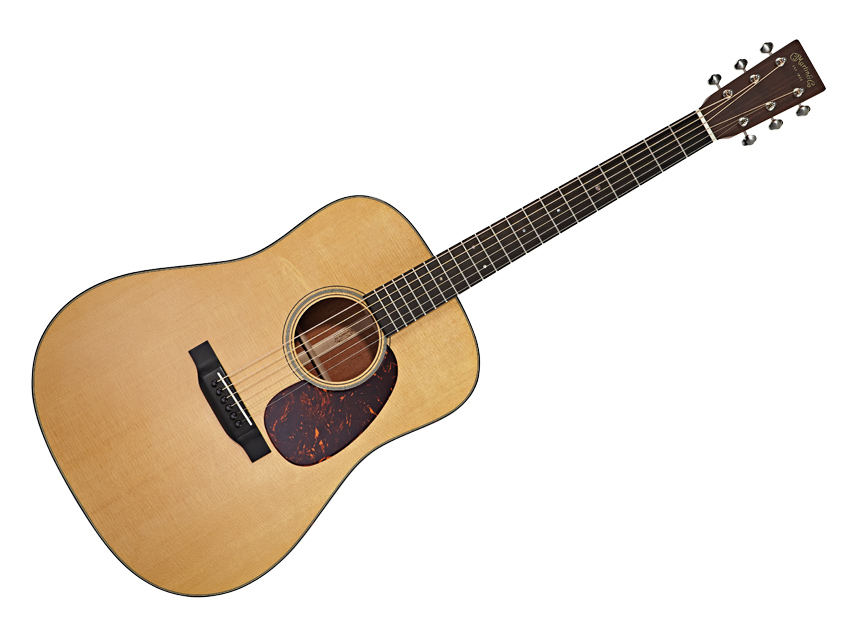MusicRadar Verdict
Martin has managed to improve and refine what was an already great guitar. This new D-18 is truly fantastic.
Pros
- +
Neck profile; build quality; classic looks; great performance.
Cons
- -
Nothing.
MusicRadar's got your back

Martin D-18

Martin D-18
Martin dreadnoughts are yardsticks in their own right, but the D-18 is a benchmark for all dreads.
Yes, there are more expensive ones available; with more decorative embellishments and exotic tonewoods. But because of its depth, balance and clarity, not to mention its ability to 'boom' and 'whisper', the D-18 is the dreadnought against which all others are measured.
"No doubt owing to the scalloped bracing and freer soundboard, we find our review model behaves more like a finely tuned race engine, reacting speedily with precision and to the slightest change in dynamics."
But what happens when its makers decide to 'update' such a well-loved model? Standing on thin ice, or the brave route forward?
There are both internal and external detail changes to the D-18. Standard 'X' bracing was used on the old D-18 whereas forward-shifted, 'X' scalloping is used here.
This means that the bracing material is gently carved along its length, which maintains strength and rigidity, but also improves the flexibility and therefore the top's propensity to vibrate.
External changes include an upgraded Delmar tortoiseshell polished and bevelled pickguard, which previously was black. We now have butterbean open-geared tuners instead of chrome enclosed types, an ebony fingerboard and bridge (instead of rosewood), plain black bridge pins - previously these were black with white dots - and an old-style Martin headstock decal that replaces the previous gold-foil type.
Interestingly for a dreadnought, the nut width has been slightly increased too, from 42.86mm to 44.45mm.
The new D-18 uses a solid Sitka spruce soundboard with a fairly tight, straight grain, though we've seen straighter on previous D-18s. Our review model's top also bears some scarring directly above the soundhole.
This 'imperfection' certainly has no detrimental effect on the guitar's rigidity or its performance, but in a retail setting some may pass over it due to its lack of uniformity.
A further difference between the new D-18s and their predecessors is aging toner. A number of Martin models now feature this 'aged' finish, designed to give a 'pre-war' look.
It does tend to divide opinion, some preferring the natural blonde hue of the spruce, others finding it somewhat anaemic. It's obviously a matter of personal taste, but we like it - particularly set against the rich, black ebony fingerboard and 1930s-style bridge.
The D-18's back and sides are formed from solid mahogany, the two-piece back being divided by a simple black Boltaron pinstripe. Both the D-18's back and front are bound with tortoiseshell effect binding, which matches the pickguard, and the soundboard binding is augmented with uncomplicated black and white coloured Boltaron coachlining.
With the exception of abalone fretboard markers and the unchanged Style 18 soundhole rosette, the D-18 has no further decorative features or embellishments. That said, it remains a pretty guitar, one that oozes style and a sense of acoustic royalty.
The satin finished, one-piece mahogany neck is fitted to the body utilising a dovetail joint and the fit and craftsmanship is first rate. In fact, every joint, line and fixing is superbly finished; Martin's typical high standards of presentation are equalled, if not bettered here.
Martin aficionados may be aware of the D-18P and D-28P; dreadnoughts from the Standard series fitted with 'Performance' necks (hence the 'P') emanating from the all-conquering Performing Artist series.
The all-new neck features a parallel profile with a slimmer taper; the result is a super-slim, super-fast neck, which has proved to be very popular. Standard series D-18s now come fitted with the performance neck as standard (making the D-18P obsolete).
Sounds
The Martin dreadnought tone is well-known and has been written about endlessly. We compared our review model to a 10-year-old D-18 that has benefited from regular playing.
As you'd expect, the older guitar has a warmer, softer, mellower output, but in every other way the new D-18 outperforms its older brother. What is perhaps most noticeable is how much more responsive the new D-18 is - it feels more 'alive' than its predecessor.
No doubt owing to the scalloped bracing and freer soundboard, we find our review model behaves more like a finely tuned race engine, reacting speedily with precision and to the slightest change in dynamics. The overall tonal output is crisp yet smooth, powerful yet controlled.
Whether gently played fingerstyle or thrashed with a heavy pick, the D-18 offers a balanced, well-rounded timbre with bags of headroom and sustain. Martin's revisions have come together to take the D-18 to another level.
In fact, we'd offer a word of warning for current D-18 owners: try the new models at your peril - you'll want one.
Steve Harvey is senior content producer for Pro Sound News and also contributes to other Future brands. He has worked in the pro audio industry — as a touring musician as well as in live production, installed sound, and equipment sales and marketing — since November 1980.
“A synthesizer that is both easy to use and fun to play whilst maintaining a decent degree of programming depth and flexibility”: PWM Mantis review
“I feel like that song had everything we needed to come back with”: Bring Me The Horizon’s Lee Malia on Shadow Moses, its riff and the secrets behind its tone, and why it was the right anthem at the right time
“I said, ‘Are we sure we can write a song about death?’”: The story of Mike + The Mechanics' classic No.1 The Living Years









